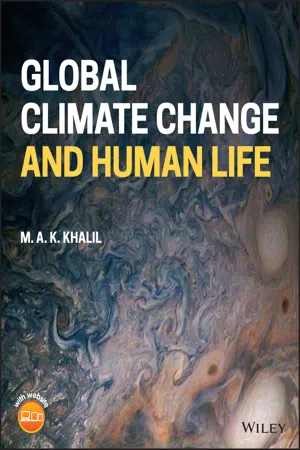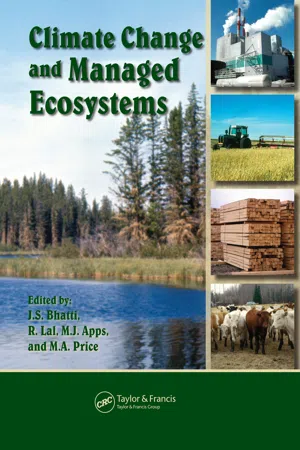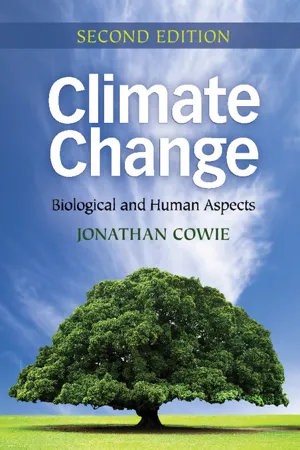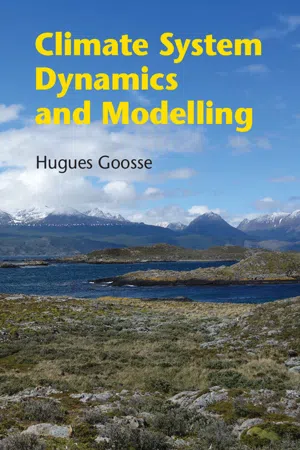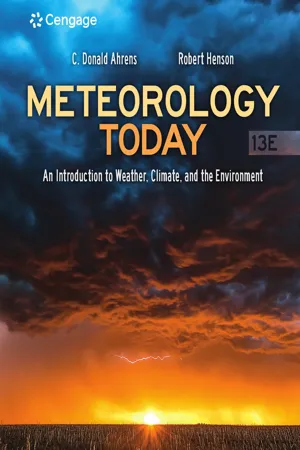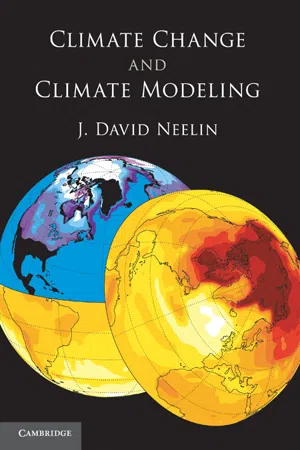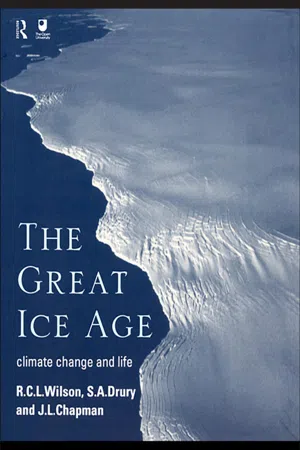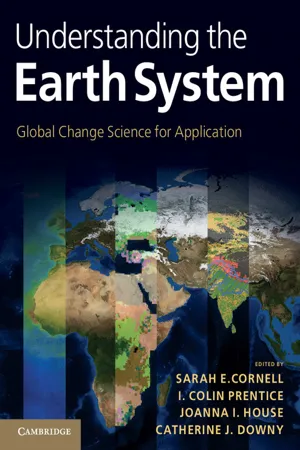Geography
Climate Change Feedback
Climate change feedback refers to the processes that either amplify or dampen the effects of climate change. These feedback mechanisms can either exacerbate or mitigate the impacts of global warming. For example, as temperatures rise, the melting of ice caps reduces the Earth's albedo, leading to further warming—a positive feedback loop. Understanding these feedbacks is crucial for predicting and addressing the consequences of climate change.
Written by Perlego with AI-assistance
Related key terms
1 of 5
11 Key excerpts on "Climate Change Feedback"
- eBook - PDF
- M. A. K. Khalil(Author)
- 2022(Publication Date)
- Wiley(Publisher)
Third, feedbacks have a complex inter-connection with each other. One can drive the other, so you can’t add them easily. While doubling CO 2 has a prescribed impact on radiative forcing, each feedback does not, because its effect depends on the other feedbacks in the system. This matter will be discussed in more detail later in this chapter. And fourth, the discussion casts feedbacks as one of the main attributes of “climate change” and sets it apart from the understanding of “the climate.” To understand how climate changes affect human life or the environment adds a further dimension that defines the new science of global change that is much more complex than climate theory can address and involves the whole earth system, and living things too. The feedbacks we have looked at in the case studies are positive. It is an important characteristic of positive climate feedbacks that they move the temperature further from the stable conditions at which the original disturbance was initiated. The idea is most clearly illustrated by the ice-albedo feedback. If we increase the temperature, by whatever means, ice on the surface will melt causing a decrease of the albedo that will add to the original cause of the warming. But, starting from the same initial state, if we decrease the temperature, as perhaps by reducing greenhouse gases, more ice will be formed and cause an increasing albedo that will drive the temperature further down than without the feedback. Positive feedbacks make a warming world warmer and a cooling world cooler. Negative feedbacks work in the opposite way. They will bring the temperature toward the stable point from which the climate was disturbed. Suppose, for the sake of illustration, that warming the earth increases low clouds and cooling reduces them. If we suddenly cool the earth, low clouds will start disappearing and when an equilibrium is reached the earth will be warmer than if the clouds were unaffected by temperature. - eBook - PDF
- Jagtar Bhatti, Rattan Lal, Michael J. Apps, Mick A. Price(Authors)
- 2005(Publication Date)
- CRC Press(Publisher)
All of these elements are interconnected, interacting parts of the climate system. If a change in one of these parts upsets the balance of that system, it is likely to initiate complex reactions in some or all of the other parts, until a new equilibrium is established. Some reactions occur very rapidly, while others occur very, very slowly. Furthermore, some may increase the initial change (a process known as positive feedback ), while others may oppose and partially offset it (a negative feedback ). The proxy data and climate observations discussed in Section 2.2 of this chapter provide invaluable information on what has happened to the Earth’s climate in the past and how it is behaving today. However, because of the complexities and non-linearity of the dynamic global climate system, these data by themselves are limited The Science of Changing Climates 31 in their usefulness to explain why the climate system changes with time and in space. Hence they also cannot be used with credibility to project how future climates might change. To develop such predictive capability, the complex feedbacks that inextri-cably couple together the various components of the climate system must fi rst be carefully studied with the help of simple models and approximated as complex mathematical equations that capture the fundamental physical, chemical, and bio-logical processes involved. These can then be integrated within a complex model of the entire dynamic global system. Such climate system models have been under development for some four decades, and are now suf fi ciently advanced to include a dynamic circulating atmosphere coupled to a circulating global ocean system with a responsive ice cover. Some modelers have now also coupled the dynamics of global ecosystems within their climate system models, thus including a representation of the biogeochemical feedbacks between the climate system and the biosphere. - eBook - PDF
Climate Change
Biological and Human Aspects
- Jonathan Cowie(Author)
- 2012(Publication Date)
- Cambridge University Press(Publisher)
1.8 Examples of interacting positive-and negative-feedback mechanisms affecting climate change. See also Figure 4.13 for an example of another feedback cycle: there are many. magnitude of this natural effect may not be as large as some might wish, hence the discussion as to whether we should deliberately fertilise the oceans with iron or take some other measure (although it would be unwise to tinker with the planet’s biosphere mechanisms without a thorough understanding of them). Given that there are feedback processes that amplify change and those that stabilise the climate, it is not surprising that changes in the global climate are not always gentle. For example, we do not see a gentle segue from a glacial to an interglacial. Instead, we see a sharp transition between the two (see Figure 1.6 ). It is as if positive feedback encourages sharp changes while negative feedback encourages stable states and that either one 28 An introduction to climate change or other of these two types of feedback dominates at any given time. The combined global climate picture is one of stable (or semi-stable) states between which there is occasional rapid flipping. One of the main pacemakers timing these flips is the combination of Milankovitch’s orbital parameters. Two questions arise from all of this. The first is whether, with current global warming, the Earth is now shifting towards a new feedback system that may encourage further warming. One example of a mechanism that might drive this is soil carbons, especially at high latitudes, and whether it may be released, through warming, into the atmosphere. Such soils include peatlands that are at so high a latitude that they are either frozen for part of the year or are permafrosts. Michelle Mack from the University of Florida and colleagues (Mack et al., 2004 ), including those from the University of Alaska Fairbanks, have looked at carbon storage in Alaskan tundra. - eBook - PDF
- Hugues Goosse(Author)
- 2015(Publication Date)
- Cambridge University Press(Publisher)
4.3 Geochemical, Biogeochemical and Biogeophysical Feedbacks 169 In addition to their direct influence on local climate, vegetation changes also may affect the temperature gradient between the different regions and the large-scale circulation. This will be discussed in the framework of the Sahara greening during the Holocene in Section 5.6.2 . 4.3.3 Calcium Carbonate Compensation Nearly all the feedbacks investigated up to this point potentially play a role on decadal to centennial time scales and thus in recent climate changes as well as in those expected over the next decades (see Section 6.2 ). In addition, other feed-backs are active on longer time scales . As discussed in Section 2.3.4 ., the burial of CaCO 3 in sediments is ultimately compensated for by the input from rivers. Because weathering and sedimenta-tion rates appear relatively independent, there is no a priori reason why these two processes should be in perfect balance at any particular time. However, any imbalance between them can lead to large variations in the stock of calcium car-bonate (and thus in the alkalinity) [see Eq. (2.48) ] in the ocean on millennial to multi-millennial time scales. This would imply significant changes in oceanic p CO 2 Atmospheric temperature Perturbation Forest coverage Surface albedo + – + – Absorption of solar radiation + Fig. 4.22 Flow graph illustrating the positive tundra-taiga feedback. A positive (negative) sign on an arrow means that an increase in one variable induces an increase (decrease) in the one pointed to by the arrow. The positive sign inside a circle indicates that the overall feedback is positive. Fig. 4.23 The difference in albedo between snow-covered forest and grass. The forest appears darker because it absorbs more of the incoming solar radiation. (Courtesy of Ali Gillet. Reproduced with permission.) Response of the Climate System to a Perturbation 170 (see Section 2.3.2 ) and atmospheric CO 2 concentration. - C. Donald Ahrens, Robert Henson(Authors)
- 2021(Publication Date)
- Cengage Learning EMEA(Publisher)
Consequently, although human-produced enhancement of the greenhouse effects could have critical impacts, there is no evi- dence that a runaway greenhouse effect ever occurred on Earth, and no indication that it will occur in the future. Another negative feedback in Earth’s climate system is the chemical weathering—CO 2 feedback. Chemical weathering is a process by which carbon dioxide is removed from the atmo- sphere as silicate minerals in rocks decompose in the presence of moisture. In this feedback, as chemical weathering increases, the amount of CO 2 in the atmosphere decreases. Chemical weathering (and the removal of CO 2 from the atmosphere) will generally take place more rapidly on a warmer planet, as chemi- cal reactions speed up and greater evaporation from the oceans *Recall from Chapter 2, p. 40, that the outgoing infrared radiation from the surface increases at a rate proportional to the fourth power of the surface’s absolute tem- perature. This relationship is called the Stefan-Boltzmann law. In effect, doubling the absolute temperature of Earth’s surface would result in 16 times more energy emitted. work; then we will consider some of the current theories as to why Earth’s climate changes naturally. 18.3a FEEDBACK MECHANISMS In Chapter 2, we learned that the Earth-atmosphere system is in a delicate balance between incoming and outgoing energy. If this balance is upset, even slightly, global climate can undergo a series of complicated changes through what are known as feed- back mechanisms. These mechanisms can operate in response to any change in energy balance, whether due to human activity or to natural causes. Let’s assume that the Earth-atmosphere system has been dis- turbed to the point that Earth has entered a slow warming trend. Over the years the temperature slowly rises, and water from the oceans rapidly evaporates into the warmer air.- eBook - PDF
- J. David Neelin(Author)
- 2010(Publication Date)
- Cambridge University Press(Publisher)
at the Earth’s surface in the warmer climate. This warms the climate still further. This is schematized in Figure 6.7 , from the point of view of the global energy balance. Of course, the snow/ice feedback, also known as the surface-albedo feedback, is felt most strongly in fairly high latitudes, and has a seasonal dependence, since it occurs at the boundary of the snow/ice cover. In Table 6.1 , it appears to be only a modest effect in the global average, but this is an average of a large effect at higher latitudes with no effect in the tropics. Thus the snow/ice feedback can be quite important to the impact of global warming. Although the basic principle of this feedback is simple, it has recently been realized that there can be considerable interaction with cloud effects, since both reflect sunlight, and since snow cover can affect the local conditions under which clouds are forming. 6.6 Cloud feedbacks Cloud feedbacks are challenging to represent in climate models for three reasons: (i) Clouds are small-scale motions compared with the grid size of climate models. Their average effects at the grid size must be parameterized on large-scale motions. (ii) Clouds have opposing effects in infrared and solar contributions to the energy budget. (iii) Several types of cloud properties can affect radiative processes: these include cloud fraction, cloud top height, cloud depth, and cloud water and ice content. Different cloud types will thus have different feedbacks. Cloud amount is usually measured as cloud fraction , i.e. for a given area, such as a 200 km square grid box, the fraction that 209 6.6 Cloud feedbacks Cooling tendency Warming tendency Net cooling tendency Increased reflection of solar by clouds IR emission from higher, colder level at cloud top Increased reflection IR emission similar to surface since warm at low levels Increased IR absorption by clouds HIGH CLOUDS LOW CLOUDS Fig. 6.8 Schematic of effects of cloud amount in the global energy balance. - eBook - PDF
Human Development Report 2007/2008
Fighting climate change: Human solidarity in a divided world
- United Nations Development Programme(Author)
- 2015(Publication Date)
- Palgrave Macmillan(Publisher)
Multiple feedbacks have been observed in ice sheet disintegra- tion. One example is the ‘albedo flip’—a process that occurs when snow and ice begin to melt. Snow-covered ice reflects back to space most of the sunlight that strikes it. When surface ice melts, darker wet ice absorbs more solar energy. The meltwater produced burrows through the ice sheet, lubricating its base, and speeding the discharge of icebergs into the ocean. As an ice sheet discharges more icebergs into the ocean, it loses mass and its surface sinks to a lower altitude, where the temperature is warmer, causing it to melt even faster. Meanwhile, warming oceans add yet another posi- tive feedback to this process, melting the offshore accumulation of ice—ice shelves—that often form a barrier between ice sheets and the ocean. The accelerated melting of permafrost in Siberia with global warm- ing is another concern. This could release vast amounts of methane— a highly potent greenhouse gas—into the atmosphere, which would increase warming and the rate at which permafrost melts. The interaction between climate change and the carbon sink capacity of rainforests provides another example of positive feedback uncertainties. Rainforests can be thought of as vast ‘carbon banks’. Trees in the Amazon region of Brazil alone store 49 billion tonnes of carbon. Another 6 billion tonnes is stored in Indonesia’s forests. As global temperatures rise, changing climate patterns could generate processes that will lead to the release of large amounts of carbon from these reservoirs. Rainforests are already contracting at an alarming rate in the face of commercial pressures, illegal logging and other activities. Under a business-as-usual scenario, climate models forecast temperatures in most of the Amazon region rising by 4–6°C by 2100. - eBook - PDF
The Warming Papers
The Scientific Foundation for the Climate Change Forecast
- David Archer, Raymond Pierrehumbert, David Archer, Raymond Pierrehumbert(Authors)
- 2013(Publication Date)
- Wiley-Blackwell(Publisher)
Even if it does not lead to a dramatic jump to a new climate state, the gap between current cli- mate and the equilibrium climate for current at- mospheric composition may have important climatic effects as it grows larger. For example, it seems possible that in the summer, when zonal winds are weak, continental regions may tend partly toward their equilibrium climate, thus causing a relatively greater warming in that sea- son. Also, in examining the climate effects of re- cent and future large volcanoes, such as the 1982 El Chichon eruption, the cooling effect of strat- ospheric aerosols must be compared to the warm- ing by trace gases which have not yet achieved their equilibrium effect; it is not obvious that a global cooling of several tenths of a degree (Robock, 1983) should actually be expected. These problems should be studied by using a global model in which the atmospheric composition changes with time in accord with measurements, and in which the atmosphere, land and ocean each have realistic response times. SUMMARY Climate sensitivity inferred from 3-D models Our analysis of climate feedbacks in 3-D models points strongly toward a net climate feedback factor of f ~ 2–4 for processes operative on 10–100 year time scales. The water vapor and sea ice feedbacks, which are believed to be rea- sonably well understood, together produce a feedback f ~ 2. The clouds in our model produce a feedback factor ~1.3, increasing the net feed- back to f = 3–4 as a result of the nonlinear way in which feedbacks combine. Present information on cloud processes is inad- equate to permit confirmation of the cloud feed- back. However, some aspects of the cloud changes in the model which contribute to the positive feedback appear to be realistic, e.g., the increase in tropical cirrus cloud cover and the increase of mean cloud altitude in conjunction with more penetrating moist convection in a warmer cli- mate. - eBook - ePub
The Great Ice Age
Climate Change and Life
- J.A. Chapman, S.A. all at The Open University Drury, R.C.L. Wilson(Authors)
- 2005(Publication Date)
- Routledge(Publisher)
Chapter 1 , a colder Earth is also a drier Earth, so cloud cover may have been reduced and so have partly compensated for the changes that increased the Earth’s albedo. Increases or decreases in the proportion of greenhouse gases in the atmosphere may raise or lower global mean surface temperatures. As explained earlier, this is because these gases absorb outgoing long-wave radiation and re-radiate energy, much of it back to the Earth’s surface.It has been estimated that the climate system’s sensitivity to atmospheric CO2 is about 1.4°C for each 100 ppm change in CO2 concentration.◻ So could CO2 changes be solely responsible for global cooling of 5°C?- Clearly they could not, as this would require—if the sensitivity value is correct—the virtual elimination of atmospheric CO2 .
The discussion of how increasing the Earth’s albedo or decreasing the proportion of CO2 in its atmosphere might cause global cooling begs the question of what might have triggered such changes. It also ignored the interconnectivity of components in the climate system. Perhaps a small change in radiative forcing might have caused ice sheets to expand sufficiently to change slightly the Earth’s albedo: this would have reduced global temperatures a fraction more, causing more ice sheet growth, and so on. This amplification of a small forcing factor is an example of a feedback process.◻ Is the example described above a negative or positive feedback effect?Figure 2.7 A comparison of the Earth’s climate system during interglacial and glacial intervals.- It is positive, as it would amplify changes in the climate system. A negative feedback acts to counter (reduce) change within a system, such as the reduction in cloud cover mentioned above that characterised a drier Earth during glacial periods.
The role of water vapour in the atmosphere is another example of positive feedback. As temperature increases, more water evaporates, increasing the concentration of water vapour in the atmosphere. Water vapour is a greenhouse gas, so the temperature rises further, causing more water to evaporate and so on. Clearly, positive feedback cannot continue to cause global cooling or warming indefinitely. If it did, the Earth would freeze or boil over! There is a limit to how extensive ice sheets can become, or to the water vapour content of the atmosphere. - eBook - PDF
Understanding the Earth System
Global Change Science for Application
- Sarah E. Cornell, I. Colin Prentice, Joanna I. House, Catherine J. Downy(Authors)
- 2012(Publication Date)
- Cambridge University Press(Publisher)
Although this can be provided by regional climate models, these have typically only been used for downscaling of radiatively forced global climate change. Climate change adapta- tion planning may therefore be misdirected if based on projections that ignore the climatic effects of land-use change and water-system change, both of which have strong human controls. The other direct effect of human activities on cli- mate which we consider here is the effect of urbaniza- tion and anthropogenic heat release. Built-up areas exert significant influences on their local climates, with an ‘urban heat island’ being observed in many cities. This effect is due partly to the influence of the urban landscape on the surface energy budget and local mete- orology, and partly from sources of heat arising from human activities (‘human energy production’). The nature of the land surface is a key factor influencing the sensitivity of near-surface climates to radiative forcing by increasing greenhouse-gas concentrations, so the responses of urban climates to radiative forcing may be different to those of non-urban climates. Moreover, Richard A. Betts et al. 177 are often not considered. For example, increased plant water-use efficiency in response to elevated CO 2 has implications for the wider hydrological cycle as reduced transpiration necessarily results in increased soil mois- ture and/or runoff (Figure 6.11). An integrated Earth system approach to modelling is needed to allow such interactions to be accounted for. Linkages between climate models and impacts models One advantage of using a chain of loosely coupled models in impacts analysis is that it allows each sub- system model to be developed to best represent the particular sub-system, such as with appropriate spa- tial resolutions and time-steps, without any constraint imposed by a need for compatibility with the other models. - eBook - PDF
- Singh, M P(Authors)
- 2021(Publication Date)
- Daya Publishing House(Publisher)
Depletion of the stratospheric ozone layer; 3. Disruptive seasonal and interannual variation in temperature and precipitation, such as the El Nino -Southern Oscillation (ENSO); and 4. Large-scale changes in land use and land cover. The climatic, ecological, and biogeochemical records of the Earth can help advance our understanding of anthropogenic effects on the Earth system. Historically, the Earth’s geography, climate, and ecosystems have suffered dramatic changes and fluctuations on timescales varying from less than a decade to millennia. Although global average conditions changes slowly, intramural to decadal variations do occur at regional (subcontinental) scales, driven by changes in sea surface temperature and ocean circulation patterns, volcanic eruptions, This ebook is exclusively for this university only. Cannot be resold/distributed. soil moisture anomalies, and variations in the amount of solar radiation reaching the Earth. Table 1.1 lists some major factors involved in global climate change. Table 1.1: In global climate change Major factors involved (after Jones, 1997). Period of Operation Factors Process and Effects xs Years to millennia Planetary orbits Gravitational pulls affect solar activity, cosmic radiation and volcanic activity. Radiation level and atmospheric capacity/reflectivity are affected Decades Sun’s Internal processes Affect solar output of electromagnetic and particulate (solar wind) radiation 20,000 to 100,000 years Earth’s orbit Distance from the Sun, angle of polar axis and seasonability affect distribution and intensity of solar radiation.
Index pages curate the most relevant extracts from our library of academic textbooks. They’ve been created using an in-house natural language model (NLM), each adding context and meaning to key research topics.
